

Edition 113 - January 2018
Published at Quepos, Province of Puntarenas, Costa Rica
Publisher: GGC Publications Group
Editor: Bob Normand, The Golden Gringo, aka "GG"
(©Copyright 2008-2018 All Rights Reserved)
"The mission and goal of the Golden Gringo Chronicles is to provide,
in an
informative and entertaining way, insight into
living
the
Costa Rican
experience as an expat."
1. Broken News: Settling on the Sele; QMA Writers Group; New Dog Species; Coffee Exports Up, or Are They Down?; Annual Quepos Boat Parade; Christmas Portal at the Market
2. Rumble and Weather Talk: Earthquake Month: November 2017 is Nominated
3. Feature: San José’s Metropolitan Cathedral (A Good Reason to Go to Church)
4. Que Es Eso? Department: An Infamous Mystery Island Back in the News
5. Feature: Small Town Stories #4 (A Lady Named Virginia - The Queen of Quepos)
6. Health Stuff: a) Geriatrics are IN; b) Just Stay Healthy and Watch the Carbs, Sugar and Salt Amigos
7. What's-in-a-Word: Answer to Que Es Eso, Etymology of Arabica
8. ROMEO Corner: Claro Que Si at Hotel Si Como No - Manuel Antonio
Wisdom of the Ages
The Kid's View TEACHER: "Harold, what do you call a person who keeps on talking when people are no longer interested?" HAROLD: "A teacher" |
The Golden Gringo and the entire staff of GGC Publications (guess who that is) wish you and yours every blessing and good wish for 2018.

¡Feliz Año Nuevo, Amigos!
Settling on the Sele
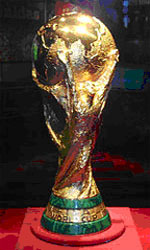 |
| FIFA World Cup |
Last month the Costa Rican National Selección Team, the "Sele", secured a spot at the FIFA World Cup futbol games in 2018 (that's soccer if you're from Rio Linda). The competition will be held in Russia between June 14 and July 15th among 36 national teams from around the world.
World Cup competition is held every four years for all the 65 teams that comprise FIFA (Federacion Internacional de Futbol Associacion). During the four years leading up to the World Cup, these teams play regular qualifying matches within their divisions. Costa Rica is part of the CONCACAF Division of FIFA. That's the acronym for the North American, Central American and Caribbean division and it includes Canada, The U.S., Mexico, the seven Central American countries and the Caribbean nations. At the end of the four year qualifying period the top three teams in points (2 for a win, 1 for a tie, 0 for a loss) represent the division and go to the cup competition.
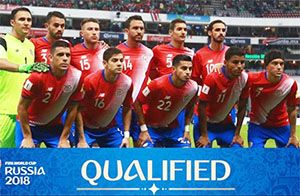 |
| The 2018 Costa Rican "Sele" |
A requirement for being on a sele team is that the player must be a native of the country he's representing, or at least a naturalized citizen thereof. Recently, it was announced that the team members for the Costa Rican Sele for 2018 had been finalized. Interestingly, the makeup of the team going to Russia next year is very similar to the one that went to the World Cup in 2014 in Brazil. The photo to the right is of the 2018 official team.
The Sele will once again be coached by Jorge Luis Pinto, a gentleman from Colombia. And you may recognized the gent in the photo in the yellow portero (goalie) uniform as Keylor Navas, the hero that got the team past Greece by blocking a critical penalty goal in 2014. Reportedly it also garnered him a seven figure annual contract playing for Real Madrid, his job when not playing on the Costa Rican sele. The Costa Rican team went all the way to the quarter finals, a very respectable performance for little Costa Rica among a field of giants.
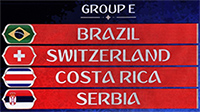 In early December, the initial eight groups of four teams each were announced and Costa Rica found itself in Group E along with Brazil, Switzerland and Serbia. Brazil is a traditional powerhouse in these games and lost only to the tournament winner, Germany, in the semi-finals in 2014. The Swiss are not to be sneezed at either (must be the fondue that gets them energized). The Ticos will face Serbia for the first time at this meet. At the end of the initial round the top two teams in each group will advance to the group of 16 from which the survivors will go on to the quarter finals, then the semis and the final for the cup.
In early December, the initial eight groups of four teams each were announced and Costa Rica found itself in Group E along with Brazil, Switzerland and Serbia. Brazil is a traditional powerhouse in these games and lost only to the tournament winner, Germany, in the semi-finals in 2014. The Swiss are not to be sneezed at either (must be the fondue that gets them energized). The Ticos will face Serbia for the first time at this meet. At the end of the initial round the top two teams in each group will advance to the group of 16 from which the survivors will go on to the quarter finals, then the semis and the final for the cup.
This coming year my Tico buddies, let's go for the gold! Go Ticos!
For those interested in writing as a profession, a career or a pastime let the word go forth (or even fifth) that the Quepos - Manuel Antonio Writers Group has been formed.
 The mission of the group is to share information on writing techniques, grammar, book structure, editing, graphic design, publishing, print-on-demand, marketing strategies and anything else appropriate to the discipline. We seek to bring together people of like ilk and interest, both experienced and novice, who can learn from each other.
The mission of the group is to share information on writing techniques, grammar, book structure, editing, graphic design, publishing, print-on-demand, marketing strategies and anything else appropriate to the discipline. We seek to bring together people of like ilk and interest, both experienced and novice, who can learn from each other.
The QMA Writers Group meets on the second Sunday of the month at El Avion Restaurant in Manuel Antonio at 12 PM followed by an a-la-carte lunch (bring your own cart). If you are interested in joining our group or attending a meeting please RSVP to bob@bobnormand.com.
“We are all apprentices in a craft where no one ever becomes a master.” — Ernest Hemingway
“It ain’t whatcha write, it’s the way atcha write it.” — Jack Kerouac
New Dog Species
Very little time passes in Costa Rica without the discovery and announcement of a new species of something wild here, be it a creature of land, sea or air or even a vegetable or plant. The latest newbie turns out to be a dog. It's not new to the globe but definitely a newcomer to Costa Rica.
 |
| The Venadero Pooch |
Now this little fella is not unfamiliar to peoples from Argentina and South America but this is the first time it has been seen north of Panama. The creature is small in stature (30 cm or 12 inches tall and 70 cm or 28 inches long) and usually is found at elevations less than 600 meters (2,000 ft) but this one was found at 1,700 meters (5,600 ft) which is about half way up the tallest mountain in Costa Rica (Chirripó).
The name of this critter is the "venadero" dog. The word venadero translates to "place much frequented by deer". These puppies feed not on deer but on small mammals such as rabbits and mice, but they are known to chase deer, evidently for sport (sometimes GG likes to do that too).
Woof.
Coffee Exports Up; or Are They Down?
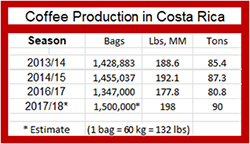 The coffee harvest here and in most of Central America runs from October to March. Recent figures released by the government confused GG (not necessarily a difficult task). The headline said "Coffee production in November was up 53%", that is to say over the same month last year. Wow, I thought to myself: self, what could have made such a dramatic change?
The coffee harvest here and in most of Central America runs from October to March. Recent figures released by the government confused GG (not necessarily a difficult task). The headline said "Coffee production in November was up 53%", that is to say over the same month last year. Wow, I thought to myself: self, what could have made such a dramatic change?
Digging a little deeper I found that, even though November production was up 53%, production in October was down 55% and combined production for the two months was off 12%. So, what exactly the production for this season will turn out to be is still in question. The coffee growers association is hoping for about a 10% increase over the 2016/17 season.
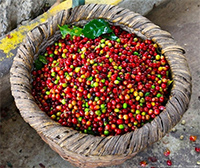 |
| Recently Harvested, Unroasted Costa Rican Coffee Beans |
 |
The typical harvesting season for coffee beans in Central America runs six months, from October to March. It seems coffee production can be significantly affected by the timing, frequency and amount of rain the plants are subjected to. For the last two or three years Costa Rica has been in the middle of El Nino, a dry and hot period with less rain. Perhaps that's why coffee production leveled off, even declined a bit in recent years (see table above).
On the other hand, we're now having La Nina and the rains have been heavier and the temperatures lower, slowing maturation. Coffee plants do best when supplied ample rain in the mid-months like April to September followed by dry, warm and sunny periods for the flowering and bead growth. But mother nature never quite gives us what we'd like for perfect conditions.
The variety of bean grown in Costa Rica is the Arabica (see What's-in-a-Word section below for the etymology of Arabica). This a quite sturdy plant but one that is still subject to certain diseases like coffee rust (hemileia vastatrix), a fungus that can eat away at the leaves and reduce production.
Keep those beans coming amigos. GG would be lost without a couple of mugs of rich, black java in the morning; no sugar, no cream, just pura Costa Rica flavor! I need to keep my new Official Golden Gringo Mug (right) filled with the natural brew to enjoy the good life. Readers can get their mug here.
Now that was a shameless plug, wasn't it?
Here's some more interesting stuff on coffee from past Chronicles editions:
Edition 42 - History of the Railroad in Costa Rica
Edition 82 - Coffee: From Scourge to Health Food
Edition 90 - More on Coffee and Health
Edition 97 - On Being a Coffee Taster
Edition 109 - Coffee Studies Again Positive
Annual Quepos Boat Parade
A new tradition has taken root in Quepos - the annual Quepos Boat Parade at Marina Pez Vela. The boat parade is held in early December and this year marked the fourth annual showing of this event. GG had gone to the boat parade in 2015 and I could not help but be impressed by the growth that has occurred in just the last two years.
A friend of mine, who is on staff at the Marina, told me that the number of boats participating in the event grew from 10 last year to 16 in 2017 and the crowd this year was estimated at 4,000, up from 2,000 in 2016. I can believe the 4k number easily as I saw people there I haven't seen in years. Remember that the immediate Quepos town population, including Manuel Antonio and Inmaculada, is about 10,000. The entire canton (county) of Quepos is only about 30,000. The event this year drew visitors from other regions, at least as far away as San José.
I took the video above in two parts - the first half was shot at dusk when the boats were just lighting up. The second half was shot when the parade had just started and when the boats were beginning to form a line. Unfortunately I had to cut it short because it started to rain and GG, unlike many of the boat admirers, had not been smart enough to secure a table in one of the covered restaurants on the top level that offer a spectacular view of the marina and parade. I'll be smarter next year...
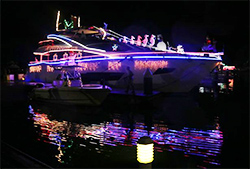 |
| The Winner, The "Gallo Pinto" |
The boat parade is in fact a competition in which the boat owners decorate their pride and joy possessions with a great array of colored lights suitable for the holiday period. There are rewards to the winner - a trophy and, even more importantly, a free "haul-out" for their boat. A haul-out is the process of lifting the boat out of the water onto a dry-dock for maintenance or other treatment. Depending on the length of the boat, a haul-out (and put-back) can be worth as much as $1,000. Like many things in boating, cost is determined by unit of boat length (be careful when ordering pizza for the boat).
The event winner this year was the same winner as last year, a yacht called the Gallo Pinto (go figure) out of Los Sueños harbor near Jacó. That's a photo of it at the right all lit up on the parade night. You can see the great effort they go to in order to decorate their boat and in this case it included a number of sea horses.
Congrats to the Gallo Pinto! And to Marina Pez Vela for their new Quepos tradition.
A Christmas Portal at the Market
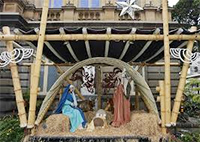 Statuary of the Christmas scene of the birth of Jesus is common in many homes and public places in Costa Rica. Many of them are quite elaborate and are valuable not only sentimentally but also for the antique statuary that has been collected over the years.
Statuary of the Christmas scene of the birth of Jesus is common in many homes and public places in Costa Rica. Many of them are quite elaborate and are valuable not only sentimentally but also for the antique statuary that has been collected over the years.
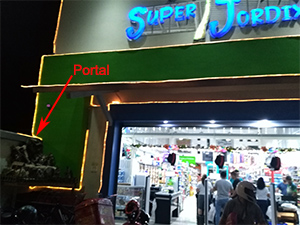 Some people around the world call it a manger scene, others a nativity scene and still others a crèche. In Italian its a presepio. In Costa Rica it's called a portal. The photo above is of the portal in front of the Teatro Nacional in San José, always one of the more elaborate ones.
Some people around the world call it a manger scene, others a nativity scene and still others a crèche. In Italian its a presepio. In Costa Rica it's called a portal. The photo above is of the portal in front of the Teatro Nacional in San José, always one of the more elaborate ones.
I was taken aback recently, actually Christmas Day evening when I stopped into my favorite supermarket, Super Jordix which is only three blocks from my apartment. For the first time this season I noticed they had a portal on the side of their main entrance (photo right). It's a little hard to see in the photo as I took it on a whim and at night.
¡Feliz Navidad, amigos!
¡Pura Vida!
 GGC Publications Group is the parent organization that publishes the Golden Gringo Chronicles as well as a number of books and paraphernalia related to the Chronicles and Costa Rica.
GGC Publications Group is the parent organization that publishes the Golden Gringo Chronicles as well as a number of books and paraphernalia related to the Chronicles and Costa Rica. The page is called GGC Publications Page - Products and has 3 sections:

 This section of the GGC Publications Page consists of descriptions of the following books published by GGC Publications:
This section of the GGC Publications Page consists of descriptions of the following books published by GGC Publications:Or go here for all of them: GGC Publications Page - Products Section I
Section II: Recommended Inspirational Books - Life Changing Stories

 S.O.B.E.R. - How the Acronyms of AA Got One Drunk Sober - by Ian Asotte (description and details HERE)
S.O.B.E.R. - How the Acronyms of AA Got One Drunk Sober - by Ian Asotte (description and details HERE)
◄To Eternal Happiness - by Abelardo Garcia, Jr. (see description and details HERE)
A Woman Awakens: Life, AfterLife - by Jan Hart (see description HERE)►
Or go here to see all of them: GGC Publications Page - Products Section II
Section III: T-Shirts and Coffee Mugs All About Costa Rica and the Chronicles
In addition, GGC Publications Group now also offers t-shirts and coffee mugs that are related to the Golden Gringo Chronicles with Costa Rican themes, to wit:

 T-Shirts: a. Golden Gringo Chronicles with Logo, b. Official Golden Gringo with Monkey on Banana Hammock, c. ¡Quepo en Quepos! ("I Fit In Quepos!") with Photo of Quepos, d. Wanna Monkey Around - Come on Down! with Photo of White Face Monkey and e. It's OK to be Slothful with photo of Three-Toed Sloth.
T-Shirts: a. Golden Gringo Chronicles with Logo, b. Official Golden Gringo with Monkey on Banana Hammock, c. ¡Quepo en Quepos! ("I Fit In Quepos!") with Photo of Quepos, d. Wanna Monkey Around - Come on Down! with Photo of White Face Monkey and e. It's OK to be Slothful with photo of Three-Toed Sloth.
Coffee Mugs: a. Golden Gringo, b. Wanna Monkey Around?, c. OK to be Slothful
¡Solo Bueno!
Earthquake Month
Now here's an interesting statistic recently reported in the press:
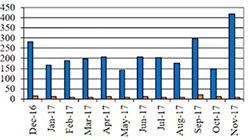 |
| Earthquake Count |
"The highest number of earthquakes registered in Costa Rica during the last 5 years were recorded in November (2017), according to a monthly report issued by the National Seismological Network (RSN)".
There were over 400 earthquakes registered in November although the report states only 41 were "detected". GG presumes that designation means the 41 were detectable by humans whereas the larger number probably includes all the readings and scratches that registered on the various seismographs, of which Costa Rica has many at the University of Costa Rica in San José and elsewhere around the country.
A cluster of 280 of these after-shakers was recorded in the days following the 6.5 terremoto that hit the Parrita-Jacó area on Sunday, November 12. To read more about that shaker, second only in strength to the September 5, 2012 monster in the Nicoya, go HERE.
As if that wasn't enough, another press report around Christmas time noted that a full quarter of the earthquakes (25%) in Costa Rica this year were epicentered in the Central Pacific region (think Jacó to Quepos). That same report stated that total earthquakes this year are down from last year, year-to-date being 2,574 down from 4,594 in 2016 but "detected" quakes are up (210 through November vs 205 for all of last year).
And there was a ♪Whole Lot of Shakin' Goin' On...♫
Check Out Recent Earthquakes Around the World Posted by the U.S. Geodetic Survey: Recent Quakes |
You can use our Archives to search for anything that has been written in more than 220 feature articles of the Golden Gringo Chronicles plus find Broken News items and ROMEO restaurant reviews. Enter your topic or item to search in the Google Search Routine below and follow the links offered from the search results. Suggestion: Enter only a simple, precise and unique as possible keyword or two in order to narrow the number of references retrieved:
Readers: Our publication is open to suggestions regarding future articles and will accept pieces written by others but we reserve the right to decline anything that the editorial staff (that's GG) thinks is inappropriate for this format. Send proposals, comments, suggestions, ideas, meaningless statements and jocular observations concerning the Chronicles to GG here: gg@goldengringo.com.
Michael Miller is a friend, fellow writer and a resident of San José for many years. He has written an English guide to our capital which, in GG's opinion, is the best one available. He has been published in the Chronicles several times and the article below is one of his latest pieces.
Like the Teatro Nacionál, the cathedral in San José is a landmark; but let's allow Michael to tell the story in his own way:
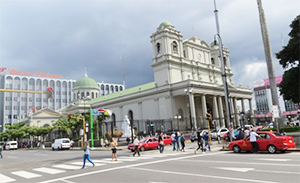 |
| Metropolitan Cathedral of San José |
Why do we go to church? If we are religious, we go to worship god. However, some of us go because it is a social event, or for others, we go because it is a social obligation (we are expected to go). When we were children, many of us went to church because our parents made us.
Here is another good reason: We can go to church because it is beautiful. In the case of the Metropolitan Cathedral, the main Catholic church in San José, it is indeed very beautiful, and it is an important building, rich with art, history and culture.
The Metropolitan Cathedral is located in the heart of Downtown San José, two blocks west of the National Theater, across the street from the city's Central Park. It is the headquarters for the Roman Catholic hierarchy in San José.
The Cathedral was built in the 1870’s after an earthquake destroyed a smaller church on the site. It was designed by a Spanish architect in a style that is considered “neoclassical.” The front of the building features a facade with three towers; a clock tower in the center and two bell towers. There are Doric pillars supporting an overhang that covers a wide front portico.
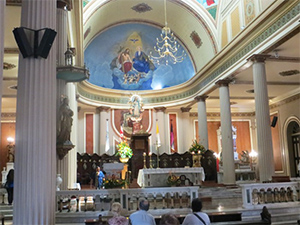 |
| Cathedral Main Altar |
Behind the facade is the long body of the church and at its eastern end is a small cupola, or dome, which covers the altar. In the Cathedral’s 140-year history, parts of the building have been closed several times for restoration and strengthening. The most recent time was in the 1990’s, after damage was caused by a series of strong earthquakes.
Once inside, you will escape the noise and the bustle of the city outside, and you cannot help but be impressed with what a peaceful, spiritual, and yes, sacred place this is. The long body, or nave, of the Cathedral features a vaulted ceiling supported by classic columns that run all the way to the altar.
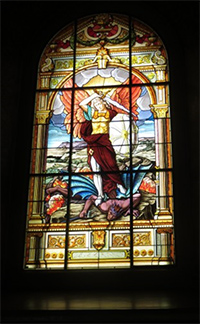 There are many things to see as you explore this historic Cathedral, but for me, the most fascinating features are the dazzling stain glass windows. These are a collection of French made masterpieces on either side of the cathedral. They are from the Champigneulle factory in Paris, and they depict Biblical scenes of Jesus, the Holy Family and various saints. One of the most moving, is a window that powerfully illustrates Saint Michael the Archangel defeating Satan.
There are many things to see as you explore this historic Cathedral, but for me, the most fascinating features are the dazzling stain glass windows. These are a collection of French made masterpieces on either side of the cathedral. They are from the Champigneulle factory in Paris, and they depict Biblical scenes of Jesus, the Holy Family and various saints. One of the most moving, is a window that powerfully illustrates Saint Michael the Archangel defeating Satan.
As you walk the length of the Cathedral, you will see fourteen bas reliefs mounted on the walls. These are the Stations of the Cross, fourteen scenes that depict the suffering of Jesus Christ on the way to His crucifixion. If you were not fortunate enough to have been raised a Catholic, the Stations of the Cross are commemorated each Friday during the season of Lent. The bas reliefs at the Cathedral were sculpted by an Italian artist and then painted with oils.
At the eastern end of the Cathedral is the magnificent altar area that is capped by the cupola. The cupola has windows around its base which allows natural sunlight to bath the altar during daylight hours. This creates a wonderful special effect: While the main body of the Cathedral is softly lit, the altar appears to glow. Above the altar is a mural of Jesus and the Holy Father.
As you face the altar, and turn to the left, you will discover a small chapel in a separate room. This is the Chapel of the Holy Sacrament. This very quiet and very solemn room, is a replica of the original chapel that was demolished. It has its own series of stain glass windows, and ornate statues of angels.
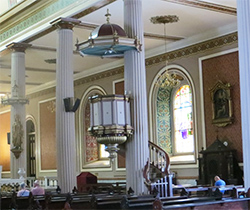 Throughout the Cathedral, you will see all kinds of interesting objects. There are statues of cherubs and paintings of holy scenes. There are life-size reproductions of Christ and the Virgin Mary. Secured to one of the columns, is a beautifully designed raised pulpit built with Costa Rican hardwood.
Throughout the Cathedral, you will see all kinds of interesting objects. There are statues of cherubs and paintings of holy scenes. There are life-size reproductions of Christ and the Virgin Mary. Secured to one of the columns, is a beautifully designed raised pulpit built with Costa Rican hardwood.
This “flying pulpit” has a winding staircase leading to it, and it is the work of a Guatemalan master craftsman who designed many of the interior features. Even the floor is beautiful, made of a painstakingly laid out colonial-style mosaic tile that runs the length of the building.
Up in the choir loft, there is a huge pipe organ imported from Belgium in the 1890’s. It is considered to be one of the most important antique organs in Central America. It has recently been restored, and it has been played by several great masters of organ music.
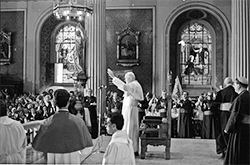 |
| John Paul II at Cathedral 1983 |
I mentioned earlier in this article that the Metropolitan Cathedral was an historic building. It has been the site of weddings and funerals of some of the most prominent people in Costa Rica’s history. However, by far and away, the most important event to take place at the Cathedral was the visit by Papa Juan Pablo Segundo (Pope John Paul II).
Pope John Paul II visited Costa Rica in 1983, less than two years after he had been shot in an assassination attempt. His Holiness said that he wanted to visit Costa Rica, and the other Central American countries, because the region was “crying out” for an end to war and hate. He celebrated mass at the Metropolitan Cathedral to a packed house of a couple hundred very lucky people. (Later he celebrated mass and spoke to a crowd of hundreds of thousands at Sabana Park.)
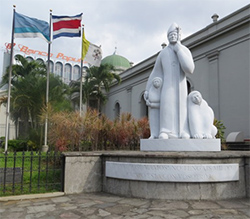 |
| Statue of John-Paul II |
Two years after the death of John Paul, San José Mayor, Johnny Araya, and a group of citizens, raised money to have a statue created to commemorate the Pope’s visit. That statue is now mounted on the northwest corner of the Cathedral’s grounds. It is the work of renowned Costa Rican sculptor Jorge Jiménez Deredia, one of the few Tico artists to gain international acclaim. It stands 12 feet high, weighs 25 tons and is made from white Carrara marble from Italy.
If you visit this beautiful old-world cathedral, be sure to be respectful if you arrive during a mass or other services. Even though this is a popular tourist attraction, it is still a place of worship. Do not go in wandering around and snapping pictures during a service. Mass is held throughout the day on Sundays starting at 7 a.m., and several times a day during the week.
You are welcome to walk through the Cathedral and to take non-flash photographs when there are no services. And gentlemen: Please remove your hats. (For some reason, a lot of guys under 30 don’t seem to know that.)
You can visit the Cathedral for free, but donations are greatly appreciated. There are donation boxes at the entrances. Keep in mind, it takes a great deal of money to maintain a building of this stature. Think about this: When it is your time to arrive at the pearly gates, and you are waiting for Saint Peter to decide which way you will go, a donation of a couple thousand colones to this beautiful Cathedral may be just enough to tip the balance in your favor.
The Metropolitan Cathedral is well worth a visit, and it is an important feature of life in Downtown San José. It is all part of The Real San José. The Metropolitan Cathedral is located on Calle Central, between Avenida 2 and Avenida 4. Its doors are open from 6 a.m. to 6 p.m.
___ ___ ___
Thank you Michael for another fine article. I've been in the Cathedral several times and it truly is a remarkable building.
To order a copy of Michael Miller's guide to downtown San José, which is called The Real San José, go HERE. Tip: The Kindle Version is a Steal at $3.99 and it's on your phone if you're walking through the city.
And check out Michael's website at: http://www.therealsanjose.com.
¡Solo Bueno!
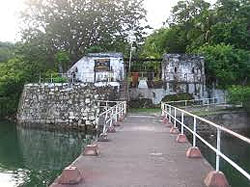
This is another Costa Rican historical site but this one has a bad history. It was the scene of one of the most egregious imprisonments in the country's history.
This place was in the news again recently because of a fire which destroyed much of the buildings that were being restored as a national historic site.
The place goes by the name of the island on which it is located. Can you name the island and identify the history here?
One of the subjects of this heinous imprisonment spent some years in this hellhole and later became the most prolific writer in the history of Costa Rica, an incredible story that is summarized in the What's-in-a-Word section below and the link to the GGC's original story.
¡Solo Bueno!
One of the first people GG met when visiting Quepos before I moved here to retire in 2008 was a lady named Virginia. At that time I quickly realized that just about everybody in town knew her and it was sad to hear recently that she had passed away. She was born Virginia Lee on May 20, 1922, grew up in Newport News, Virginia and died a nonagenarian on November 6, 2017 at the age of 95.
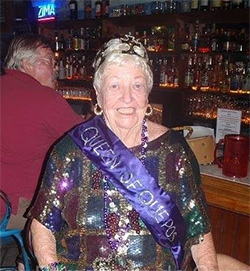 |
| Virginia Utley - The Queen of Quepos |
Over the years, the lady married and became Virginia Lee Utley and they had one son, Bill who lives in Quepos today. Virginia's husband later retired as a full Colonel in the U.S. Air Force and had passed away before she moved to Costa Rica.
When Virginia first arrived in Costa Rica from St. Petersburg, Florida in 1974 or 1975, she lived in San José for one or two years. Eventually she purchased a property in Quepos in what is now called the American Zone or La Zona Americana. She substantially remodeled the house and lived there until her death.
The American Zone. and much of Quepos as well, owes its initial existence to La Compania de la Bananeras (basically, the Banana Company). The original local banana company was sold to United Fruit Company which later became Chiquita Brands. The American Zone was where the bananas were hauled into the dock area and transshipped by ocean freighter. It also had been developed by the banana company into a barrio containing schools, the first Quepos hospital and a recreation club known as the American Club.
By the time Virginia arrived on the scene, the banana industry in Quepos was on the decline due to an infestation of banana blight in local plantations. Eventually these farms were converted to African Palm for palm oil production. Nevertheless, the American Zone was a vibrant barrio within the Quepos community and Virginia and her home were right in the middle of it. Virginia was actively involved in the Quepos community and attended social gatherings and is reported to have often bowled with the Banana Club* (see below) people. Yes, Dorothy, there once was a bowling alley in Quepos (see N.B. below).
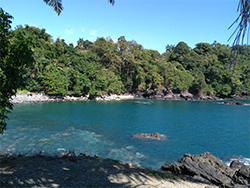 |
| The Cove at Parque Naomi (Street Level) |
The house Virginia constructed overlooks one of the most beautiful inlets along this part of the coast. The area below is a beautiful, rocky cove with a public park known as Parque Naomi, situated just south and west of the new marina. The cove at street level is shown in the photo right. According to Julie, one of Virginia's closest friends, she loved to throw parties on the patio of her house with the spectacular view of the cove and the Pacific beyond.
She also loved to open her home to Christmas celebrations including tree trimming parties. Some of her expat friends, as close friends often do, christened her with a nickname, "Vicki", while Ticos were fond of calling her "Mami" (Mom).
GG asked the question of her friends; how did she become the "Queen of Quepos"? Evidently, some Ticos first started calling her "Mi Reina" and it stuck. When asked once how she got to be Queen she answered with her typical good sense of humor: "You just live here over 40 years and get to be so damn old!" The Queen of Quepos moniker never went away and eventually the queen was crowned and received the royal sash as shown in the photo of her at the top of this article.
The Queen of Quepos will be dearly missed but her subjects are grateful for her long reign.
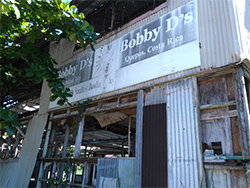 |
| Quepos Bowling Alley - "Bobby D's" |
N.B. Yes, believe it or not, there once was a bowling alley in Quepos. It was called Bobby D's and it was within walking distance of the current Marina, Virginia's house, the Banana Company Club, the old hospital and the current Costa Rica Coast Guard Academy, in other words all of the American Zone.
GG came across the old building in a recent walk-about of the area and a photo of what remains of the abandoned and dilapidated building is shown to the right. It billed itself as possibly "The Smallest Bowling Ally in the World?".
| Note: The information given in this section is offered as news information only and does not indicate GGC confirmation or denial of the accuracy of the treatment or a recommendation to pursue it, nor can we or do we guarantee the efficacy of the results nor validity of the conclusions proffered.
(How's that for a disclaimer?) |
Geriatrics are IN
A recent press report noted that geriatric specialists are now available at most Costa Rican hospitals and that the goal is to have 100% coverage in the near future (thanks amigos, just in time for GG). The report also stated that the number of graduate doctors entering this field has risen from 10 to 16 annually.
In the nine years since GG moved here I have witnessed a broadening of staff and offerings at out little Quepos Hospital and the regional clinics (called Ebais). I'm hoping for opthalmology next so I don't have to make that 2 1/2 hour bus trip to Puntarenas for check-ups and post-cataract surgery adjustments.
Watch Your Intake and Drink Coffee
Nothing much new to report on the dietary scene - just watch the carbs, sugar and salt my friends. If you have normal blood pressure, drink good Costa Rican coffee; it's another health food. In case you missed the positive points about coffee, go HERE.
 |
Answer to Que Es Eso?
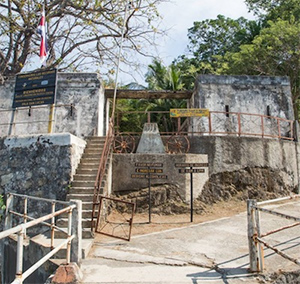 |
| Dock and Entryway at Isla San Lucas |
The picture above and to the right is of Isla San Lucas island which was Costa Rica's version of Devil's Island located in the bay of Nicoya. It was used as a prison up until the 1970's.
An unusual twist to the story of Isla San Lucas came to us because of a famous prisoner who was housed there from 1950 to 1969, a Tico named José León Sánchez Alvarado. This is a man that came from poor campesino stock, who was falsely accused of the major crime of robbing the Cartago cathedral of a precious and famous relic. He was thrown into San Lucas as Prisoner #1713. While in prison, León learned to write, then later wrote a famous book that he named "The Island of Lonely Men" after San Lucas. The book eventually sold over 2,000,000 copies (even before Amazon and POD).
León eventually became the most prolific writer in Costa Rican history. Wow! What a story. To read the whole story about Señor León go HERE).
The island 's prison facility, which was under renovation, was recently damaged by a fire of unknown origin and authorities are determining what else can and must be done to preserve this National Historical-Architectural Heritage Site.
Arabica
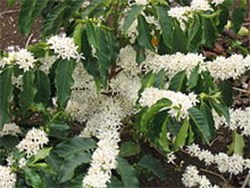 |
| Arabica Plant in Flower |
The photo of the coffee beans shown in the article on coffee exports in the Broken News section above is of arabica beans.
Arabica is a species of the Coffea plant originally indigenous to the forests of the southwestern highlands of Ethiopia. It is also known as "Arabian coffee", "coffee shrub of Arabia", "mountain coffee", or "arabica coffee". About 60% of total global production of coffee is arabica while the preponderance of the balance is the "robusta" bean which is less acidic, more bitter and has a higher caffeine content. In Costa Rica, by law, only arabica beans are allowed to be grown (works for me).
Arabica plants can grow to nine to twelve meters (30-40 feet!) tall. The flowers of the arabica plant are small and white, 10–15 mm in diameter and grow in clusters. The seeds are contained in a drupe (commonly called a "cherry") 10–15 mm in diameter, maturing bright red to purple and typically containing two seeds (the coffee beans). Source: Wikipedia.
Call it what you will, GG just likes the way it tastes.
Paragraph Symbol
 You may have noticed and recognized the paragraph symbol used in the new Quepos-Manuel Antonio Writers Group logo above in the Broken News section. That's a paragraph symbol used in writing and the formal name of this symbol is a pilcrow.
You may have noticed and recognized the paragraph symbol used in the new Quepos-Manuel Antonio Writers Group logo above in the Broken News section. That's a paragraph symbol used in writing and the formal name of this symbol is a pilcrow.
Thought you might want to know (I didn't know either).
Claro Que Si at Si Como No Hotel - Manuel Antonio
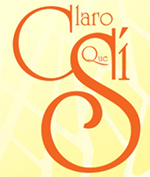 Location: Top of Manuel Antonio hill on the ocean side of the road across from the Hotel Byblos and
next to the "Regaleme" gift shop.
Location: Top of Manuel Antonio hill on the ocean side of the road across from the Hotel Byblos and
next to the "Regaleme" gift shop.
Hours: Lunch and Dinner Daily (11 AM to 10 PM)
Parking: In front of restaurant - adequate to accommodate the restaurant seating.
Contact: Tel: 2777 0777, Email: information@sicomono.com; Website: http://www.sicomono.com
Reviewing ROMEOS: Alma L., Anita M., Bob N., Glen N., Julia S., Kathleen K., Kathy P., Lance M., Mary M.
To Review Our Rating System and Procedure, go here: R.O.M.E.O. Rating System
This restaurant was last reviewed by the ROMEOs in August of 2014 - see that review HERE. We ended up at Claro Que Si this time as a third choice after learning that our original target, Fred's Place, had closed (also reviewed in 2014). We then redirected ourselves to Aqua Azul, another one needing a re-review, but they could not accommodate our group nor would they make a reservation. As it turned out we got the better part of that decision.
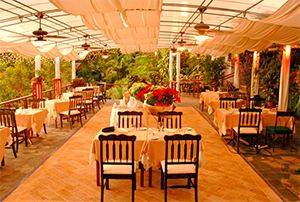 Claro Que Si translates to English as Of Course! or Certainly! or By All Means! This is in a hotel named Si Como No which, in a verbatim English translation, is a contradiction as Yes Like No! but better translates as a meaning of Yes, of Course! Both terms sound like a positive attitude to me.
Claro Que Si translates to English as Of Course! or Certainly! or By All Means! This is in a hotel named Si Como No which, in a verbatim English translation, is a contradiction as Yes Like No! but better translates as a meaning of Yes, of Course! Both terms sound like a positive attitude to me.
The Claro Que Si restaurant is one of two at the Hotel Si Como No. The main dining room (right) is open to the atmosphere and surrounded by the Manuel Antonio jungle with a slice of the Pacific Ocean off in the distance. The dining room has a sleek, modern but comfortable look and feel about it. We got there after sunset and the lighting was pleasant and sufficient to easily read the menu (that's worth a point in GG's book).
The nine ROMEOs gave Claro Que Si an average rating of 4.5 out of 5 maximum sloths for atmosphere/ambiance.
The menu has a nice variety of foods to chose from but the emphasis is definitely on seafood. The variety of offerings was apparent from the main courses the ROMEOs eventually selected: Vegetarian Mushroom Ceviche, Stuffed Chicken Kabobs Glazed with Mango, Blackened Mahi-Mahi, Shrimp-Quacamole Taco, Rib Eye Steak and a Surf and Turf for two consisting of Shrimp, Steak and Lobster.
GG, claro que si, went for three courses (I love to splurge at ROMEO dinners). I started with a seafood soup, a delicate brown stock in which were swimming a few clams, baby shrimp, mussels, pulpo (sliced rings of octopus or squid), and a touch of crab. Excellent.
For the main course I joined a friend and had the stuffed chicken croquets glazed in mango and served with a small melange of fresh vegetables. Delicious.
For dessert, we were offered what I call the "MA Standard" to select from: a) brownie with ice cream, b) coconut flan, c) cheesecake or d) tiramisu. The good news was that the quality and taste in each of these was above standard.
The ROMEOs ended up giving Claro Que Si a composite score for food quality of 4.8/5 sloths. |
 |
|---|---|
| $$$$.1 | |
Value Index= 113 |
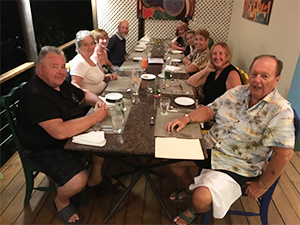 |
| ROMEOs Once More Hard at Work (Somebody Tell the Fat Dude on the Right to Close His Mouth and Stop Talking) |
We were served by two young men, Tony and Maykol who were pleasant, friendly and helpful. They were a little slow on the uptake for the bread refill circuit but overall they provided good service for which we gave them a composite score of 4.6. That yielded a combined composite score of 4.63/5 for ambiance, food quality and service.
For GG's three courses, the seafood soup, stuffed chicken croquettes (they were more like kabobs), tiramisu and a soft drink the bill , including the standard and legally required 10% service charge and 13% tax came to $39. While that's not cheap, it's typical and not outrageous for first class eating in this resort area. The composite ROMEO score for cost was 4.1$ (remember, the ROMEO $ rating runs opposite to the sloth ratings - 1$ is cheapest and 5$ is most expensive).
That gave the Claro Que Si a value index of 4.63/4.1x100= 113, above average for the restaurants we've reviewed in this area.
The ROMEO Club can easily recommend Claro Que Si for very good food at a fair price.
¡Pura Vida!
The Golden Gringo Chronicles is a free newsletter that is non-political, non-commercial and, hopefully, entertaining. By signing up you will receive an email each month around the first of the month giving you the links to the latest edition as well as to each individual feature and departmental section.
CLICK HERE TO SIGN-UP FOR THE
GOLDEN GRINGO CHRONICLES
or Email me at gg@goldengringo.com, and see our Website at: www.goldengringo.com

Bob Normand, Editor & The Golden Gringo
Pura Vida!
To Contact GGC World Headquarters (yuk, yuk) to make comments, suggest topics or criticize my bad jokes, just send an email to: gg@goldengringo.com.
Be pithy but kind; I'm sensitive. (center)
Unsubscribe from Golden Gringo Chronicles